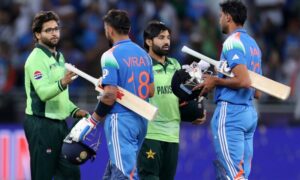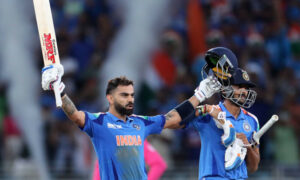Irrespective of their durability and quality, a number of Chinese products have not only made deeper inroads in Pakistani markets — either through legal imports, informal channels, or joint ventures for local assembly — but have also gained popularity among the masses due to their affordability.
Some Chinese imports, official or illegal, have literally wiped out local assemblers in the past. Currently, local artificial jewellery makers have been struggling to improve their market share amid stiff competition with finished Chinese goods.
But what has led to the entry of artificial Chinese jewellery? Many market pundits feel that record-high gold prices have led to a boom in artificial jewellery demand as people can no longer afford pure gold ornaments and jewellery.
However, according to Mohammad Hussain, Vice President, Small Traders Artificial Jewellery and General Merchant Association, “It is only a myth that rising gold prices have created an extraordinary demand for artificial jewellery in Pakistan. In reality, Indian dramas have brought this cultural change all over the world.”
Soaring gold prices, cheap bulk imports from China, and changing fashion trends drive purchases
The overall boom in artificial jewellery sales was mainly triggered by the Indian dramas on Star Plus and other channels some 20 years back. The dramas created a niche among the new and old generations who preferred wearing similar jewellery for weddings, valimas, and private parties to match their outfits.
As the import of Indian jewellery has not been in vogue for over 20 years, Chinese products have taken the market by storm. And though some local Pakistani small and medium-sized manufacturers have emerged, followed by some big makers anticipating the soaring demand, they have yet to compete with Chinese quality and finishing in the last 20 years.
Some shopkeepers still try to confuse consumers by selling local and Chinese jewellery as ‘Made in India’, but in reality, these are not Indian goods.
Mr Hussain explains “Despite a mushroom growth of local manufacturers, the sale of Chinese jewellery holds a 70 per cent market share while the local industry has a 30pc share.”
China has the advantage of its cheap raw materials and latest machines, while local production is slightly pricier as Pakistani manufacturers have to import raw materials from China and struggle to keep competitive prices amid unbearable utility bills.
Despite this hardship, local makers continuously strive to earn their market share. “Our locally made products can become cheaper if we get raw materials at low rates or the government provides some kind of incentives on raw material imports,” Mr Hussain hoped.
Karachi has over 100 small and medium-sized makers engaged in local manufacturing, while some 10 big units also exist in the port city. In contrast, some cities in Punjab have more than 500 small and medium-sized units each and a greater number of big units than Karachi.
On the sale of overall artificial jewellery items in the wake of gold prices reaching over Rs0.3 million per tola of 24kt gold, Mr Hussian claimed, “Our sales have risen by 25-30pc in the last one and a half years instead of a big boom as people assume.”
Furthermore, for the last three years, westernised stainless steel jewellery has been in high demand as women have become fascinated by world-leading brand names like Coco Chanel, Calvin Klein, Cartier, Dior, etc., although these items lack originality. “All these westernised unbranded items with the tag of branded items are also arriving from China,” he claimed.
A number of small and medium-sized pure gold jewellers, perturbed by dwindling jewellery sales, have switched to manufacturing artificial jewellery in the last year to survive in the markets.
Local importers also place orders in China, following the latest trends in the artificial jewellery world. Many Pakistani people, who usually lift the items in bulk from the wholesale hub at Marriot Road Boulton Market in Karachi, have opened online jewellery sale businesses as well.
Plastic jewellery items have also become popular in the last three to four years, but again, China rules the markets despite local manufacturing of these items.
That said, amid the impressive market share of Chinese jewellery, the local industry has produced a number of jobs. For example, a small factory has at least 100 directly or indirectly engaged, while big factories have around 300 workers.
Consumers are taking a costly ride by paying more than wholesale prices, as retailers have no limit on profit margins. During Ramazan, or a few days ahead of Eidul Fitr, the profit margin doubles or triples from the procurement prices.
The starting wholesale price of an average bridal set is over Rs1,000 while the wholesale price of a good quality bridal set ranges between Rs5,000-6,000. Consumers usually pay Rs10,000-12,000 for an artificial jewellery bridal set, and it is up to sharp-minded ladies how they bargain with the shopkeepers.
Mr Hussain said an artificial jewellery item, which carries the wholesale price of Rs100-300, enjoys a market share of 60-65pc followed by items carrying a price of Rs 400-1,000 that have a 30pc share, leaving a 5-10pc share for items between Rs2,000-5,000. Fancy jewellery holds only a 1pc market share. It is hard to assess the total market size of artificial jewellery with no credible official data.
“A 40ft container ranges carried jewellery worth $25,000-30,000 of metal, stainless steel, and plastic,” Mr Hussain says, adding that the assessment value of jewellery depends on the quality, ranging from $3 per kg to $15 per kg.
Published in Dawn, The Business and Finance Weekly, February 17th, 2025
- Desk Reporthttps://foresightmags.com/author/admin/










